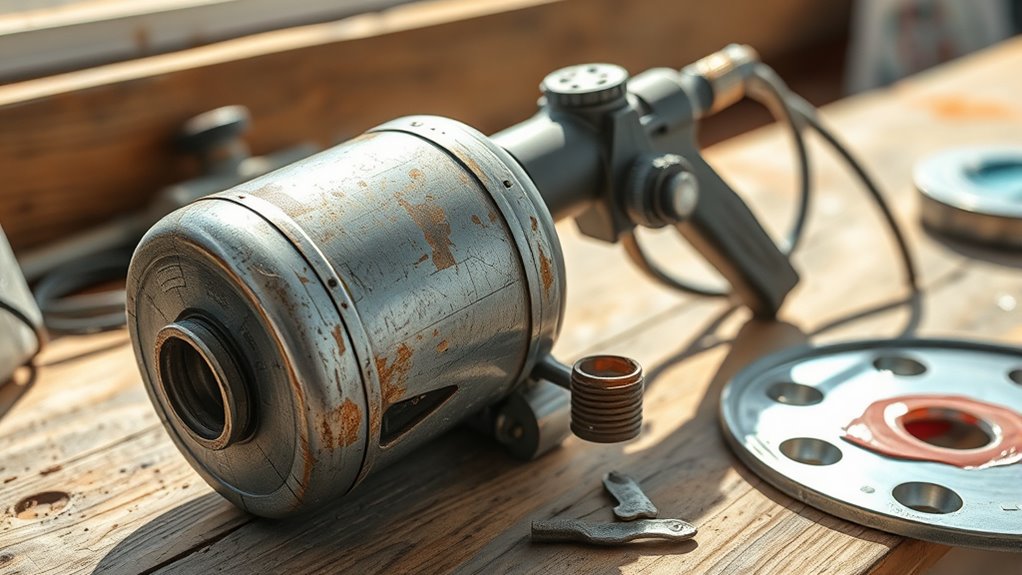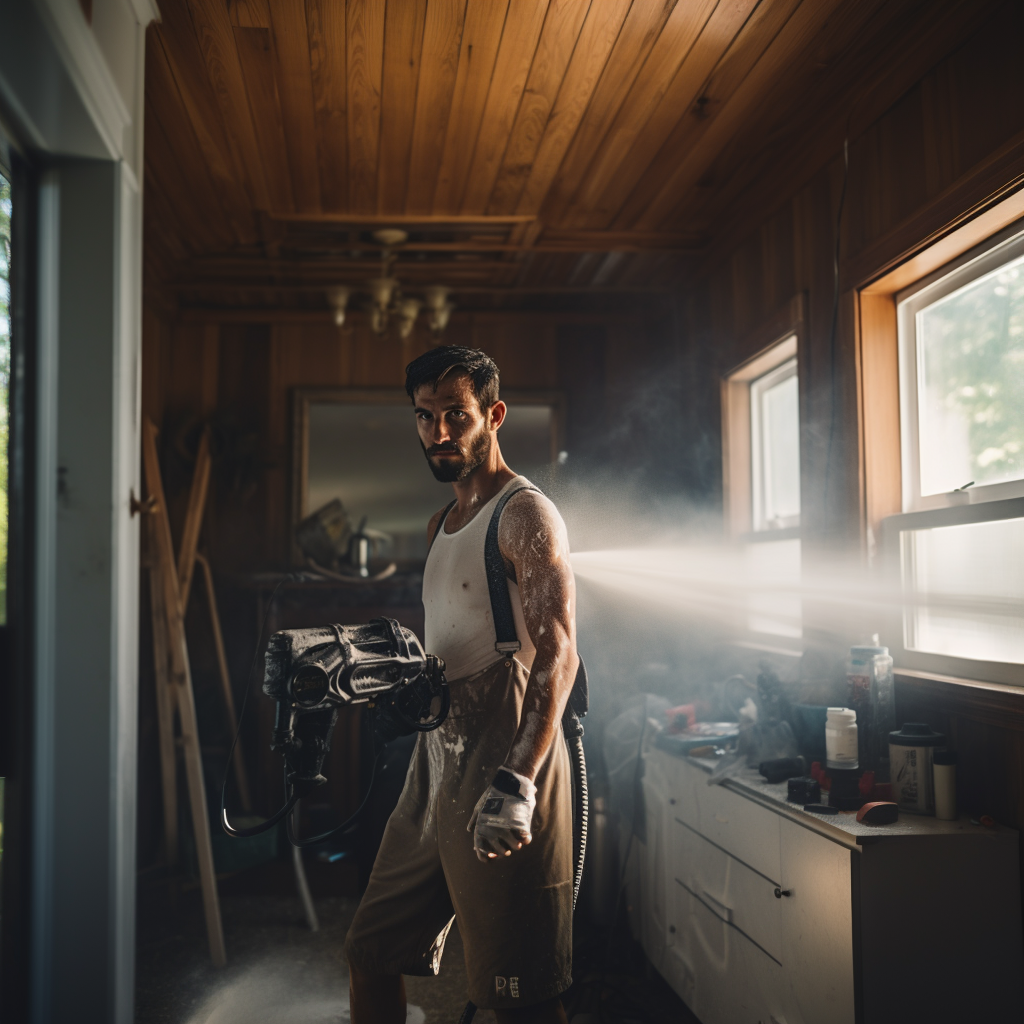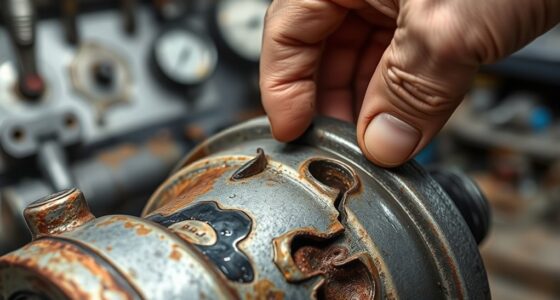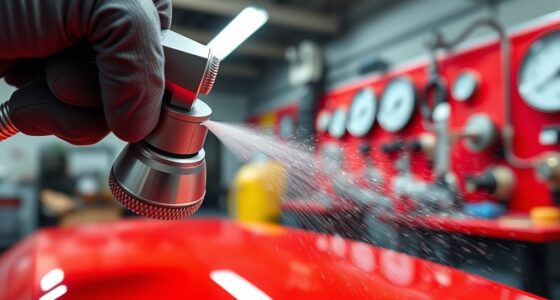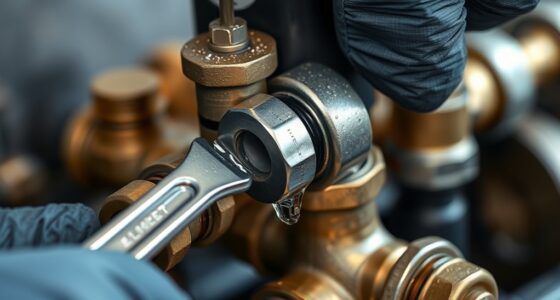To revive a neglected paint sprayer, start by thoroughly cleaning all parts that come into contact with paint, like nozzles, filters, and hoses, using the right solvents or water-based cleaners. Inspect and replace worn filters, nozzles, and damaged hoses to prevent blockages and leaks. Check internal components for dried paint buildup and lubricate or replace seals as needed. Adjust pressure settings and ensure your paint mixture is properly thinned for smooth operation—more tips will help you get your sprayer back in action.
Key Takeaways
- Disassemble and thoroughly clean all contact parts with appropriate solvents or warm water and mild soap.
- Inspect and replace clogged filters and worn nozzles to restore proper spray pattern.
- Check hoses and internal components for damage, cracks, or dried paint buildup; replace or lubricate as needed.
- Test the sprayer with water, adjust pressure settings, and ensure proper paint consistency before actual use.
- Perform regular preventative maintenance, including cleaning, inspection, and addressing leaks to prolong equipment life.
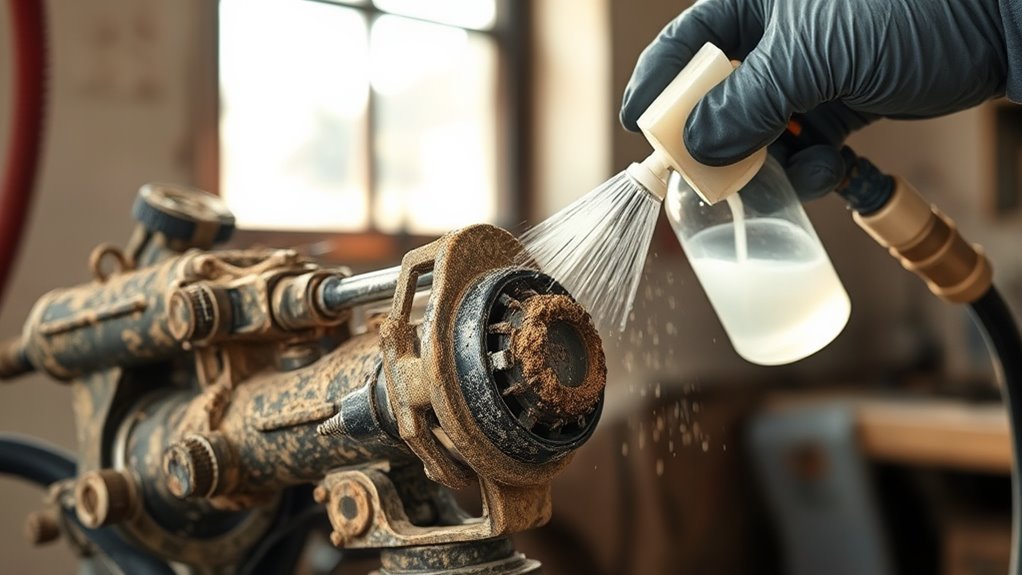
If your paint sprayer has been sitting unused for a while, it might not work as smoothly as it once did. Over time, dust, dried paint, and lack of use can cause clogs, leaks, or inconsistent spray patterns. To revive your sprayer, start with basic maintenance tips to troubleshoot common issues. First, disassemble the parts that come into contact with paint—such as the nozzle, filters, and hose—and give them a thorough cleaning. Use warm water and mild soap if you’re working with water-based paints, or a suitable solvent for oil-based paints. This step clears out any dried or hardened paint that could be blocking the flow.
Next, check the filters for debris or damage. Dirty or clogged filters often cause uneven spray patterns or pressure drops. Replace them if necessary. While you’re at it, inspect the nozzle for any clogs or wear. A clogged nozzle can considerably reduce spray quality, so clear any obstructions with a soft brush or replace the nozzle if it’s worn out. It’s also wise to examine the hose for cracks or leaks, as compromised hoses can lead to pressure loss or inconsistent paint delivery.
Once you’ve cleaned and inspected these parts, reassemble the sprayer and test it with water first. If it still sputters or produces uneven spray, double-check the pressure settings and make sure the paint mixture isn’t too thick, which can cause strain on the equipment. Thinning the paint according to the manufacturer’s recommendations often improves performance. Sometimes, a simple adjustment in the pressure regulator can resolve issues like inconsistent flow or excessive overspray.
If you’re still experiencing problems, consider inspecting the internal components, such as the pump or seals. Dried paint inside the pump can cause it to seize or work inefficiently. Applying a pump lubricant or replacing worn seals can restore proper functionality. Keep in mind that common issues like air leaks or worn parts are often due to lack of maintenance, so regular upkeep can prevent many problems from occurring in the first place. Additionally, using the correct paint consistency can significantly improve your results and prolong the lifespan of your equipment.
Frequently Asked Questions
How Often Should I Perform Maintenance on My Paint Sprayer?
To keep your paint sprayer in top shape, you should perform regular paint sprayer maintenance, ideally after each use. Cleaning frequency depends on the type of paint you use, but generally, you should clean the equipment thoroughly once you’re done painting. This prevents clogs and guarantees smooth operation. Regular maintenance helps avoid costly repairs and prolongs your sprayer’s lifespan, making your projects easier and more efficient.
Can I Use Alternative Cleaning Solutions for My Sprayer?
Have you ever wondered if there are safer ways to clean your paint sprayer? Yes, you can use chemical alternatives or eco-friendly cleaners, but make sure they’re compatible with your equipment. Are these substitutes effective in removing paint residues without damaging your sprayer? Always check manufacturer guidelines first, and test a small area. Using environmentally friendly cleaners can protect your equipment and the planet, giving you peace of mind.
What Are Signs My Paint Sprayer Needs Repair?
You’ll notice your paint sprayer needs repair if you experience paint flow issues or strange noises during operation. These signs indicate potential clogs, worn parts, or motor problems. Don’t ignore these symptoms, as they can worsen over time. Check for blockages, leaks, or unusual sounds, and address them promptly to prevent further damage. Regular maintenance helps keep your sprayer functioning smoothly and extends its lifespan.
Is It Safe to Disassemble My Sprayer Myself?
Disassembling your paint sprayer can be safe if you follow proper safety precautions and are familiar with your tools. Always unplug the equipment before starting, wear protective gear, and work in a well-ventilated area. Make sure you understand the device’s components and consult the user manual. If you’re unsure or uncomfortable, consider seeking professional help to prevent damage or injury. Your safety and the sprayer’s integrity come first.
How Long Does It Typically Take to Fully Revive a Neglected Sprayer?
Did you know that proper cleaning frequency can double a paint sprayer’s equipment lifespan? Reviving a neglected sprayer usually takes anywhere from a few hours to a day, depending on how long it’s been unused. If you’re diligent with cleaning and maintenance, you can avoid lengthy repairs. However, if it’s been neglected for months, expect a more thorough overhaul that might take longer to fully revive your equipment.
Conclusion
As you finish reassembling your sprayer, you notice a faint smell of fresh paint lingering in the air—like a sign that everything’s working perfectly. Just yesterday, it sat untouched and forgotten, but now, with a little patience and effort, it’s ready to bring your projects back to life. Sometimes, it’s the small reminders—like that unexpected whiff—that show your equipment’s revival is truly within reach. Now, you’re all set to create again.
Franz came aboard the Paint Sprayer Zone team with a background in both journalism and home renovation. His articulate writing style, combined with a passion for DIY projects, makes him an invaluable asset. Franz has a knack for breaking down technical jargon into easy-to-understand content, ensuring that even the most novice of readers can grasp the complexities of paint sprayers.
